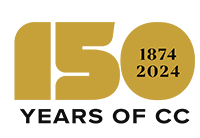CompSci Takes a Turn
Computer Science Takes a Turn
Historically in small liberal arts colleges, computer science had to swim upstream. Attracting computer science faculty and equipping appropriate labs was an expensive proposition. So it was at Colorado College that computer science developed in spurts and relied heavily on the developing interests of the mathematics faculty. At the turn of the twenty-first century, the computer science torch was carried by Steven Janke, Peter Staab, and Jennifer Beaudin (the computer science paraprofessional). The department as a whole was quite supportive, and indeed, Kathy Merrill and Jane McDougall pitched in to cover the early computer science courses. There were glimmers of changes in many directions.
- Jennifer Beaudin's strong skills supported efforts in web programming, Linux programming, and graphics. She took the department web pages to a new level and along with Janke and Staab designed a web programming course for the 2001 winter semester. Staab shifted gears in the non-majors introduction to computer science and tried a new curriculum designed around JavaScript. Janke taught the fledgling operating system adjunct course centered on Linux and both Beaudin and Staab pitched in to develop material for the course. It was decided at the end of 2000 that in the 2001-2002 academic year, the department would shift to JAVA as the main programming language after PASCAL had served its purpose. In the spring of 2001, Staab put together a JAVA programming environment on the campus network and taught an upper level programming course to test out JAVA in the curriculum. All went well, and with the addition of two new people, computer science took a turn.
- As computer science paraprofessional for two years, Jennifer Beaudin showed the department how helpful and essential the position could be. The department had been trying for several years to convert the position into a full time technical director position. In the spring of 2001, the college finally agreed. Jennifer Beaudin went off to graduate school, and the department hired Amy Pacheco as the first technical director. This new designation offered the promise of continuity and stability for a key position in the department.
- Dave Roeder was a major player in the early development of computer science at the college. On his retirement, the department searched for a computer scientist to replace him, and Jonathan Bredin, a fresh Ph.D. from Dartmouth, accepted the position. Bredin was the first faculty member to join the Mathematics Department with a Ph.D. in computer science. He arrived in the fall of 2001 and was key in easing the transition to JAVA. His expertise also prompted the department to immediately approve changing the operating system course from an adjunct course to a full block course. This change was simply indicative of the new promise of course opportunities in computer science.
- It was also in the spring of 2001 that the department was asked by the college to consider moving to the newly proposed Tutt Science Building. Although historically and emotionally tied to Palmer Hall, the department decided to sign on for the move believing that this was the only way to guarantee better space and new computer labs. With two new computer labs in the blueprints, the prospects for computer science brightened.
- Once Jonathan Bredin had settled in, the demand for computer science had grown to the point that a full major was in order. Together, Bredin and Janke designed a major curriculum more or less in keeping with the programs already appearing in many liberal arts colleges across the country. The major included Computer Science I and II followed by Computer Organization, electives drawn from Databases, Distributed Computing, Graphics, Artificial Intelligence, and special topics offered occasionally. There was a decidedly mathematical bent with the requirement of calculus and with the addition of two senior level courses, Theory of Computation and Analysis of Algorithms. The new major became official in 2005 and marked the beginning of continued growth in the computer science program.
- With Bredin's departure and Matthew Whitehead's arrival, the computer science major evolved further. An Application Design course offered early in the curriculum attempted to expand the allure of computer science and fill a gap in student ability to build more applied programs. The course morphed after several years into a Software Design course at the sophomore level. Whitehead offered a mobile computing course and along with Janke breathed new life into an adjunct course in robotics. A final addition came in the form of a Senior project which was intended as a year-long software design project.
- With the addition of Ben Ylvisaker and, soon after, Janet Burge, the program evolved further as it became clearer which courses worked well and which needed redesign. A first programming course called Computational Thinking was added, the Software Design course matured, and at the upper division level a programming languages course and web design course both showed up in the selection of elective courses. Burge brought further industry experience to the program and soon the department enticed an alum (Richard Koo) who had success in the computer industry to teach an occasional course. The resulting applied perspective balanced the program even further.
Report an issue -
Last updated: 05/28/2024



